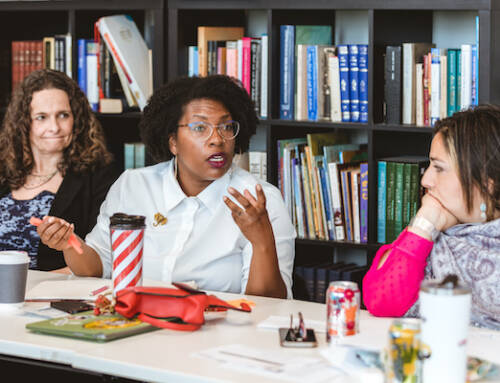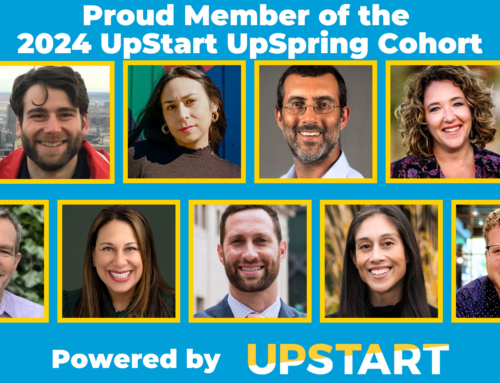The Talmud in Shabbat 22b recounts a debate about the core mitzvah of Chanukah: Is the mitzvah lighting the candles (hadlaka), or is the mitzvah placing them (hanacha) where they can be widely seen? On the one hand, the entire purpose of lighting the Chanukiah is the lighting itself illuminating the darkness, bringing that flickering light into being. On the other, if the light is hidden away, if it is not shared, what is actually being accomplished?

The Day School Collaboration Network (DSCN), a collaboration between The Jewish Education Project and UpStart with funding from UJA-Federation of New York, was originally conceived as a lab of sorts, one that would produce innovative solutions to some of the most pressing challenges facing the Jewish day school world.
The hope was that teams of teachers from select New York area day schools would identify challenges and opportunities that were pressing in their schools and in the field at large, and would come up with ideas that could be applied system-wide. As DSCN enters its third year, it has become clear that though teams have generated creative ideas that have helped their schools make progress around difficult issues, they have not yielded packaged solutions that can be seamlessly replicated in other institutions. Often, their ideas and prototypes (initial iterations of possible solutions) lead to the identification of other pressing challenges which then need to be addressed, and the conceived solution must be scrapped in the face of other challenges that demand new ideas.
However, we have found that when people step up to address systemic challenges with the creative tools provided by design thinking and the insights provided by adaptive leadership theory, they become inspiring change-agents in their schools, and slowly begin to transform the culture. The teams that are part of this network have courageously tackled issues that are notoriously difficult to solve, that are beyond the scope of their immediate circles of responsibilities, and that, when addressed, could greatly benefit their schools and the broader day school community.
Lamplighters Yeshivah, a Montessori school in Crown Heights, Brooklyn, began with the challenge How might we help teachers, parents and students connect deeply? To gather insights, they introduced an Innovation Council to their school community in which all stakeholders may suggest and discuss ideas. They decided to use Chanukah as a platform for connection. They subsequently developed a new question: How might we create meaningful Chanukah programming that engages parents, teachers and children? They imagined, prototyped and piloted a host of ideas, including publishing a serial podcast in which students dramatize the story of Chanukah, a Menorah lighting organized by parents, a staff potluck event, a hashtag for parents and teachers to use for Chanukah photographs in and out of school, and a multi-media contest in which families submit creative answers to the question What is a Lamplighter? Ingeniously, the contest is being facilitated by parents and judged by grandparents.
The team from Yeshiva Darchei Torah expanded to include a parent as they looked into ways to build collaboration between the school staff and parent body. A town hall meeting and parent survey led to the realization that the more important question was: How might we help teachers and parents be aware of the real needs and values of the other? Mazel Day School began with: How might we help students solve conflicts on their own? As they researched the challenge, they moved to the elegantly stated How might we help students reframe their expectations and understanding of a healthy relationship/friendship? They are now exploring ways the students might design this program.
The Gemara ultimately concludes that the core of the mitzvah is the lighting. One of its proofs is that the blessing we say is lehadlik ner shel Chanukah to light the Chanukah candle and not lehaniach ner Chanukah not to set the Chanukah candles in place. The first step, which is the most critical, is to create the light. Once the light is shining, if it is a true light, it will inevitably be placed, and will inspire and ignite others.
DSC03456As a community striving to create the most widespread and effective changes and growth, we need to seek structures that are replicable, measurable, and applicable to all. What we have seen from our work at DSCN is that it is more likely that those scalable concepts are actually processes new ways of working and thinking rather than packaged products. And we should remember that the true source of light comes from those unique moments of passion that transform the individuals involved, who then ignite and transform others. These steps, these individual lights, are perhaps what our system as a whole needs most.
Maya Bernstein is an Associate at UpStart.
Bryna Leider is the Director of the Day School Collaboration Network at The Jewish Education Project.
This blog is cross-posted on eJewish philanthropy.
Our purpose is to enable entrepreneurs to bring bold Jewish ideas to light. We help them reach Up to people in new ways that are meaningful, more inclusive, and create a brighter future for our Jewish community and the world we share.




